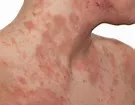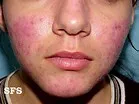Did you know that there are more than 3,000 skin disorders known to dermatology? We will examine the three most common skin disorders, Eczema, Psoriasis, and Rosacea. We will also look at the best ways to treat these skin disorders. Is your skin itchy, oozing, or breaking out? Changes in color or texture can result from inflammation, infection, or allergic reactions anywhere on the body. Some skin disorders can be minor, temporary, and easily treated, while others can be very serious, and even life-threatening.
Skin Disorders – Eczema
Eczema is a term for a group of medical conditions that cause the skin to become inflamed or irritated. The most common type of eczema is known as atopic dermatitis or atopic eczema. Atopic refers to a group of diseases with an often-inherited tendency to develop other allergic conditions, such as asthma and hay fever.

Skin disorders like Eczema can affect about 10% to 20% of infants and about 3% of adults/children in the U.S. Furthermore, most infants who develop the condition outgrow it by their tenth birthday. Some people continue to have symptoms on and off throughout life. You can control the disease with proper treatment.
What Are The Symptoms Of Eczema?
In most cases, eczema is always itchy. Sometimes the itching will start before the rash appears. When it does, the rash most commonly appears on the face, back of the knees, wrists, hands, or feet. It may also affect other areas as well.
Affected areas usually appear very dry, thickened, or scaly. For fair-skinned people, these areas may initially appear reddish and then turn brown. Among darker-skinned people, eczema can affect pigmentation, making the affected area lighter or darker.
Treatment For Eczema
Current medical treatments focus on reducing itching and swelling, but they tend to only focus on making the symptoms more bearable, and some of them come at the cost of nasty side effects:
Antihistamines:
This is a good start, but current medical research is still cautious to claim this is an effective therapy on its own because it doesn’t treat the skin, it only treats the itchiness. Furthermore, antihistamines cause drowsiness and leave you sluggish all day.
Antibiotics:
To address the irritating bacteria, doctors may prescribe antibiotics in serious cases. This is not a long-term option, it can make matters worse. Antibiotics kill our GOOD and BAD bacteria, which weakens our immune system, leaving you nearly defenseless against eczema.
Topical Steroid Creams:
Topical steroid use results in diminishing effectiveness. Once users discontinue topical steroids, eczema can be devastating. Continued use can thin the skin and cause permanent pigment changes, even hormonal changes and hair loss. (Consult your doctor before taking on any new regimen).
To get a good moisturizer for your skin, click on the direct link here > https://www.anrdoezrs.net/click-8268793-13914692
Skin Disorders – Psoriasis
Psoriasis is a long-lasting autoimmune disease characterized by patches of abnormal skin. These skin patches are typically red, dry, itchy, and scaly. For people with darker skin, the patches may be purple. Skin disorders like psoriasis can vary in severity from small, localized patches to complete body coverage. The Koebner Phenomenon is the appearance of skin lesions on lines of trauma. It may result from either a linear exposure or irritation.
Types of Psoriasis

There are five main types of psoriasis: plaque, guttate, inverse, pustular, and erythrodermic. Plaque psoriasis, also known as psoriasis Vulgaris, makes up about 90 percent of cases. It typically presents as red patches with white scales on top. Areas of the body most commonly affected are the back of the forearm, shin, navel area, and scalp. Guttate psoriasis has drop-shaped lesions. Pustular psoriasis presents as small non-infectious pus-filled blisters. Inverse psoriasis forms red patches in skin folds. Erythrodermic psoriasis occurs when the rash becomes very widespread and can develop from any of the other types. Fingernails and toenails are affected by most people with psoriasis at some point in time. This may include pits in the nails or changes in nail color.
Certain environmental factors trigger Psoriasis. In twin studies, identical twins were three times more likely to be affected than non-identical twins. Symptoms often worsen during winter with certain medications, such as beta-blockers or NSAIDs. Infections and psychological stress can also play a role. Psoriasis is not contagious. The underlying mechanism involves the immune system reacting to skin cells. Diagnosis is typically based on signs and symptoms.
Treatment for Psoriasis
There is no cure for psoriasis. However, various treatments can help control the symptoms. These treatments include steroid creams, vitamin D3 cream, ultraviolet light, and immune system-suppressing medications, such as methotrexate. About 75 percent of skin involvement improves with creams alone. The disease affects two to four percent of the population. Psoriasis affects all genders equally. The disease may begin at any age but typically starts in adulthood. An increased risk of psoriatic arthritis comes with skin disorders as well as lymphomas, cardiovascular disease, Crohn’s disease, and depression. Psoriatic arthritis affects up to 30 percent of individuals with psoriasis.
Skin Disorders – Rosacea
Rosacea is a long-term skin condition that typically affects the face. It results in redness, pimples, swelling, and small and superficial dilated blood vessels. Often, the nose, cheeks, forehead, and chin are most involved. A red, enlarged nose may occur in severe diseases, a condition known as rhinophyma.
Causes

A family history of the condition is one of the risk factors. Other factors that may potentially worsen the condition include heat, exercise, sunlight, cold, spicy food, alcohol, menopause, psychological stress, or steroid cream on the face. The diagnosis is based on symptoms.
The exact cause of rosacea is unknown. Triggers that cause episodes of flushing and blushing play a part in its development. Exposure to temperature extremes, strenuous exercise, heat from sunlight, severe sunburn, stress, anxiety, cold wind, and moving to a warm or hot environment from a cold one, such as heated shops and offices during the winter, can each cause the face to become flushed. Certain foods and drinks can also trigger flushing. These include alcohol, foods, and beverages containing caffeine (especially hot tea and coffee), foods high in histamines, and spicy foods.
Medications and topical irritants can trigger Rosacea flare-ups. Some acne and wrinkle treatments reported causing rosacea include microdermabrasion and chemical peels. Also, high dosages of isotretinoin, benzoyl peroxide, and tretinoin.
The use of topical steroids can induce Rosacea. For seborrheic dermatitis, steroids are often prescribed. To avoid flare-ups, the dosage should be slowly decreased and not immediately stopped.
Treatment for Rosacea
Treating rosacea varies depending on severity and subtypes. Dermatologists recommend a subtype-directed approach to treat rosacea patients. Mild cases are often not treated at all or are simply covered up with normal cosmetics.
In addition, therapy for the treatment of rosacea is not curative. It is best measured in terms of a reduction in the amount of facial redness and inflammatory lesions, a decrease in the number, duration, and intensity of flares, and concomitant symptoms of itching, burning, and tenderness. The two primary modalities of rosacea treatment are topical and oral antibiotic agents. Laser therapy has also been classified as a form of treatment. Medications often produce a temporary remission of redness within a few weeks. However, by suspending treatment, redness typically returns. Long-term treatment, usually 1–2 years, may result in permanent control of the condition for some patients. Lifelong treatment is often necessary, although some cases resolve after a while and go into permanent remission. Also, if left untreated, other cases, worsen over time.
Behavior
Avoiding triggers that worsen the condition can help reduce the onset of rosacea. But avoidance alone will not normally lead to remission except in mild cases.
In addition, one should avoid excessive exposure to the sun. Some people with rosacea benefit from the daily use of sunscreen. Others can opt to wear hats with broad brims. Like sunlight, emotional stress can also trigger rosacea. Some people who develop infections of the eyelids must practice frequent eyelid hygiene.
Managing pre-trigger events such as prolonged exposure to cool environments can directly influence warm room flushing.
Medications
Medications with good evidence include topical ivermectin, azelaic acid creams, brimonidine, doxycycline, and isotretinoin by mouth. Lesser evidence supports topical metronidazole cream and tetracycline by mouth.
Metronidazole acts through anti-inflammatory mechanisms. Azelaic acid will decrease cathelicidin production. Also, 0ral antibiotics of the tetracycline class such as doxycycline, minocycline, and oxytetracycline are commonly used. They are thought to reduce papulopustular lesions through anti-inflammatory actions rather than through their antibacterial capabilities.
Using alpha-hydroxy acid peels may help relieve redness caused by irritation and reduce the number of papules and pustules associated with rosacea. Oral antibiotics may help relieve symptoms of ocular rosacea. Also, isotretinoin is the treatment if papules and pustules persist. The topical application of alpha agonists such as brimonidine, oxymetazoline, or xylometazoline can treat the flushing and blushing that accompanies Rosacea.
Laser
Evidence of the use of lasers and intense pulsed-light therapy in treating Rosacea is poor.
